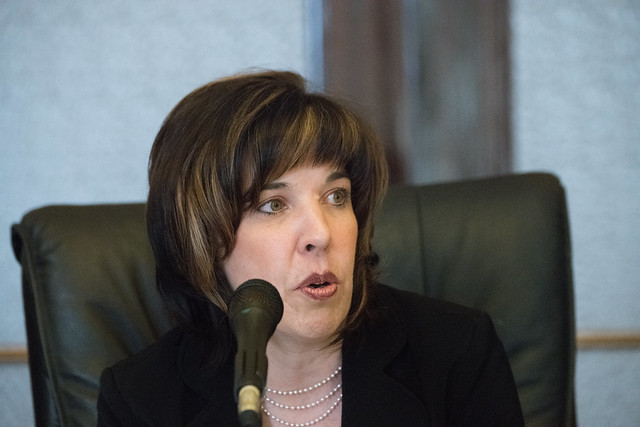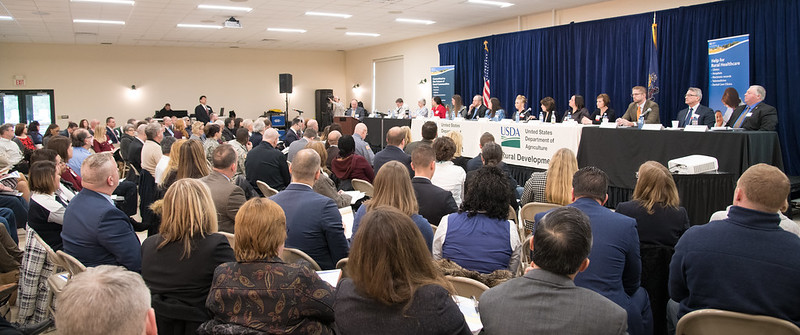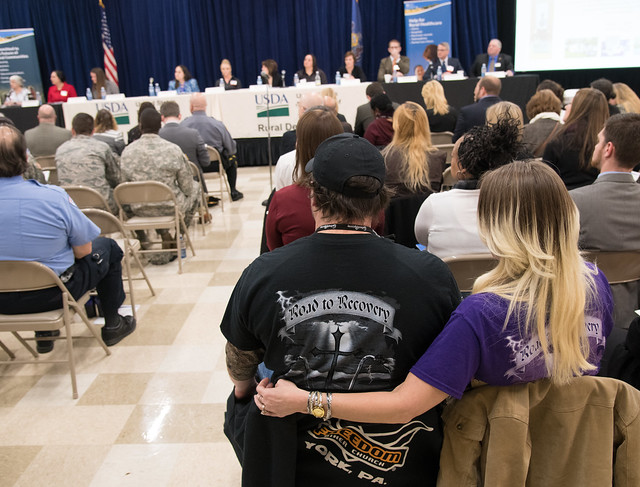
This was a speech originally read by USDA’s Assistant to the Secretary for Rural Development Anne Hazlett at the National Rx Abuse and Heroin Summit in Atlanta, Georgia.
Good evening everyone! I am incredibly honored to be with you today -- and to be part of this conversation about an issue that I believe is critical to the future of rural America. The opioid epidemic and the destruction it is wrecking on rural communities across our country is almost a daily occurrence in the headlines. If you are like me, it is easy to grow numb to the depth of its darkness and the nightmare that this issue is creating in scores of small towns and rural places from Oregon to Maine. However, I believe it is imperative for every one of us to be engaged.
Several months ago, Nancy Hale, who many of you know as the passionate force behind Operation Unite, gave me a bracelet which simply reads: “Life Counts.” Each of you are living out that mission -- and as we face this battle together, I am most grateful for this opportunity to share what the Department of Agriculture is doing to be a strong and hopeful partner to rural communities in response to this epidemic.
My own roots in the opioid crisis stem back to 2015 when my home state of Indiana made national headlines after the small community of Austin experienced an HIV outbreak of historic proportions -- due to injection drug use. While many headlines turned first and foremost to the disease, those conditions were merely a symptom of a much deeper wound.
I can vividly recall a day in the spring of 2016 when Nancy Stearns, a science teacher at the local high school, told me -- with tears rolling down her cheeks -- that in her 7 years of teaching, she had already lost 56 of her former students to a drug overdose. Nancy teaches STEM education at Austin High School. With her hands held up in sheer surrender, she said to me: “Anne, how can I teach these kids about a periodic table when their most basic needs aren’t being met -- and they are physically sick worrying about their mom at home who is strung out on drugs?”. With that reality, the future for many of these students is defined not by their God-given potential but by the circumstances of their family living in the grip of addiction. Beyond Nancy and her students, the exponential impact of losing 56 young lives in a community of only 4,000 people is almost too painful to comprehend.
While no corner of our country has gone untouched, the impact of the opioid crisis on small towns and rural places like Austin has been particularly significant. Last October, the CDC reported that the numbers of drug related deaths are rising in rural areas, surpassing rates in urban centers. And, in November -- two leading farm organizations, the American Farm Bureau and National Farmers Union, released a study which showed nearly 50 percent of rural adults -- and 74 percent of farmers -- have been directly impacted by opioid abuse.

Under the leadership of President Trump and Secretary Perdue, our team at the Department of Agriculture is focused on increasing economic opportunity and improving the quality of life in rural America. With that focus, the opioid epidemic is more than a health issue; this is a matter of rural prosperity. In small towns from east to west, north to south, this crisis is impacting worker productivity, increasing health care demands, and putting enormous stress on limited emergency response, law enforcement, and social services.
This issue is also making economic development even more difficult for rural communities that are already running on slim budgets and struggling to attract new business. Just last month at the White House Opioid Summit, the significance of that impact was brought into painful focus when a local official from Mercer County, WV described the extreme financial stress that the epidemic has created for his community -- after the jail bill is paid, there is little to no money left over for the economic development activity which his county so desperately needs.
As we partner with rural leaders to address this tremendous challenge, the President has deployed an all hands on deck approach across his Administration on this issue. With a keen focus on rural prosperity, the Department of Agriculture is strongly engaged in tackling the opioid epidemic on several fronts: First, we have a number of program resources that can be used to help communities with prevention, treatment, and recovery. Congress substantially increased our funding to make these critical investments in the recent spending bill passed for 2018. And, we are wasting no time in putting these resources to work.
Today, we are announcing that we are giving priority in our Distance Learning and Telemedicine Program for projects that address the opioid epidemic in rural America. This program provides grant assistance to communities building a remote connection for education or health care services. In addition to telemedicine, we are also announcing the availability of $5 million in grant funding through our Community Facilities Program -- investing up to $150,000 for projects that will build innovative community infrastructure or deploy equipment to best address the opioid crisis.
Second, to help communities connect to these resources we have also launched an opioids webpage on the USDA website. There, local leaders can find information about our programs and how to apply. They will also find news updates, best practices and links to the resources of our partners -- resources like FarmTownStrong.com -- a website created by the Farm Bureau and Farmers Union to help farm families impacted by this issue.
Last week, we added a new feature to the site called: “What’s Working In Your Town?” Here, rural leaders can share what is making a difference in their communities -- and, this information will then be used to build a map of successes in prevention, treatment, and recovery in rural America. With the real world experience in this room today, we would love to get your input and feedback using this tool.
Lastly, beyond our own resources, USDA is building strategic partnerships and facilitating the adoption of best practices. In March, we kicked off a series of regional roundtables designed to help better understand the unique needs of rural communities in this battle -- and to learn from what is already working on the ground in rural America. These events began in Pennsylvania and will move next to Utah and Kentucky.
The best practices we glean from these conversations can then be a resource to other local leaders. Beyond best practices, we are also using these conversations to better shape our own efforts -- and the activity of other rural interests -- to be an effective partner to local communities.
With that, I want to close today by sharing some wisdom I have learned in serving rural America during the course of this incredibly difficult issue. First, I have learned that rural is different. The opioid epidemic has hit rural America particularly hard for many unique reasons -- such as lack of access to health care, isolation, and economic decline. And, likewise, an effective response to address this issue in small towns will look different than big cities -- in some cases, requiring innovation in delivery of services such as telemedicine, mobile treatment clinics and peer recovery coaches.
Second, I have learned that relationships matter in this fight. If there is one silver bullet in this issue, I believe that is it. On their Farmtownstrong website, the Farm Bureau and Farmers Union make a bold declaration that farm towns will overcome the opioid epidemic through strong farmer-to-farmer support and the resilience of our communities. And, from my own observations both at USDA and in ministry I could not agree more.
I have seen firsthand the power of community to defeat addiction in a ministry called Hope2Others. Every Thursday, H2O founders Billy and Dana Snowden host teen night -- offering a safe place for kids in a small town where families have been torn apart by addiction and generational poverty. These nights begin with a dinner followed by games and time just to hang out -- allowing kids who have seen so much evil to feel safe and loved. Sometimes the meal is as simple as bologna sandwiches and Oreo cookies, but that simple nourishment is changing lives. With this small act of kindness, Billy and Dana are using the power of relationship to change the course of history for these children -- helping them to magnify their vision for the future beyond the darkness of their current circumstances and giving them a sense of worth that is too great for the cycle of poverty and addiction to continue no matter what example has been set at home.
In H2O, we see that the solution to the opioid epidemic is not all about the big stuff -- certainly we need partners like Farm Bureau, like the Rural Health Association, like USDA working together to build healthy communities. But, just as much, this is about the little things -- neighbors helping neighbors to find hope. Just like Billy and Dana, this is something that EACH of us can do today.
And, finally, I have learned that while we cannot deny the truly devastating nature of this crisis for many rural places -- there is a bright spot to this story which we cannot afford to miss. I have seen that for some communities, the tragedy of this issue has become a powerful catalyst for broader change -- bringing community members together to tackle difficult and underlying challenges that need to be addressed -- regardless of the drugs.
I think about places like Scott County, Indiana and Portsmouth, Ohio where community leaders like Lori Croasdell (the local substance abuse coalition coordinator) and Tammy Walker (the county extension agent) are diving into tough issues like generational poverty, parenting skills, and workforce training. And, as the seeds of their work take root -- the future for Nancy Stearns and her students back at Austin High School begins to look very different. Instead of seeing another young life being cut far too short, Nancy will reap the rewards of her passion for these kids -- of her academic and emotional investments in their lives -- watching with joy as her students move on from her STEM education class to become the next engineer at the local food processing plant there in Austin.
While it took a tragedy like drugs to rally leaders to climb these mountains, these towns are battling back. With reconciliation in families and renewal in community relationships, these places are reclaiming their identity -- and casting a new vision for what lies ahead. In that transformation, I find great hope -- and a huge opportunity for a bright future in rural America. Standing together, we can build healthy and vibrant rural communities now and for generations to come.

